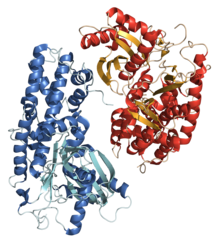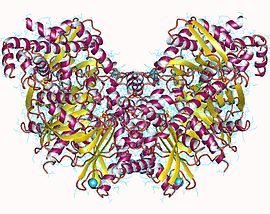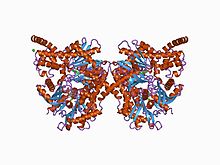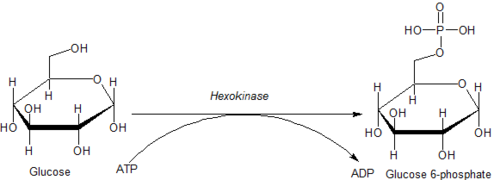1. What purpose is served by the phosphorylation of glucose to glucose-6-phosphate by hexokinase?
| Hexokinase | |||||||||
|---|---|---|---|---|---|---|---|---|---|
 Crystal structures of hexokinase ane from Kluyveromyces lactis.[one] | |||||||||
| Identifiers | |||||||||
| EC no. | ii.vii.1.1 | ||||||||
| CAS no. | 9001-51-8 | ||||||||
| Databases | |||||||||
| IntEnz | IntEnz view | ||||||||
| BRENDA | BRENDA entry | ||||||||
| ExPASy | NiceZyme view | ||||||||
| KEGG | KEGG entry | ||||||||
| MetaCyc | metabolic pathway | ||||||||
| PRIAM | profile | ||||||||
| PDB structures | RCSB PDB PDBe PDBsum | ||||||||
| Gene Ontology | AmiGO / QuickGO | ||||||||
| |||||||||
| hexokinase ane | |||||||
|---|---|---|---|---|---|---|---|
 Hexokinase one, homodimer, Man | |||||||
| Identifiers | |||||||
| Symbol | HK1 | ||||||
| NCBI cistron | 3098 | ||||||
| HGNC | 4922 | ||||||
| OMIM | 142600 | ||||||
| RefSeq | NM_000188 | ||||||
| UniProt | P19367 | ||||||
| Other data | |||||||
| Locus | Chr. 10 q22 | ||||||
| |||||||
| hexokinase 2 | |||||||
|---|---|---|---|---|---|---|---|
| Identifiers | |||||||
| Symbol | HK2 | ||||||
| NCBI gene | 3099 | ||||||
| HGNC | 4923 | ||||||
| OMIM | 601125 | ||||||
| RefSeq | NM_000189 | ||||||
| UniProt | P52789 | ||||||
| Other information | |||||||
| Locus | Chr. 2 p13 | ||||||
| |||||||
| hexokinase three (white cell) | |||||||
|---|---|---|---|---|---|---|---|
| Identifiers | |||||||
| Symbol | HK3 | ||||||
| NCBI gene | 3101 | ||||||
| HGNC | 4925 | ||||||
| OMIM | 142570 | ||||||
| RefSeq | NM_002115 | ||||||
| UniProt | P52790 | ||||||
| Other data | |||||||
| Locus | Chr. v q35.2 | ||||||
| |||||||
| Hexokinase_1 | |||||||||
|---|---|---|---|---|---|---|---|---|---|
 crystal structure of homo glucokinase | |||||||||
| Identifiers | |||||||||
| Symbol | Hexokinase_1 | ||||||||
| Pfam | PF00349 | ||||||||
| Pfam clan | CL0108 | ||||||||
| InterPro | IPR022672 | ||||||||
| PROSITE | PDOC00370 | ||||||||
| SCOP2 | 1cza / SCOPe / SUPFAM | ||||||||
| |||||||||
| Hexokinase_2 | |||||||||
|---|---|---|---|---|---|---|---|---|---|
 rat brain hexokinase type i circuitous with glucose and inhibitor glucose-vi-phosphate | |||||||||
| Identifiers | |||||||||
| Symbol | Hexokinase_2 | ||||||||
| Pfam | PF03727 | ||||||||
| Pfam association | CL0108 | ||||||||
| InterPro | IPR022673 | ||||||||
| PROSITE | PDOC00370 | ||||||||
| SCOP2 | 1cza / SCOPe / SUPFAM | ||||||||
| |||||||||
A hexokinase is an enzyme that phosphorylates hexoses (vi-carbon sugars), forming hexose phosphate. In most organisms, glucose is the about important substrate for hexokinases, and glucose-6-phosphate is the most important product. Hexokinase possesses the power to transfer an inorganic phosphate grouping from ATP to a substrate.
Hexokinases should not be confused with glucokinase, which is a specific isoform of hexokinase. All hexokinases are capable of phosphorylating several hexoses but glucokinase acts with a 50-fold lower substrate affinity and its main hexose substrate is glucose.
Variation [edit]
Genes that encode hexokinase take been discovered in every domain of life, and exist amid a variety of species that range from leaner, yeast, and plants to humans and other vertebrates. They are categorized equally actin fold proteins, sharing a mutual ATP binding site core that is surrounded by more variable sequences which determine substrate affinities and other properties.
Several hexokinase isoforms or isozymes that provide different functions can occur in a single species.
Reaction [edit]
The intracellular reactions mediated by hexokinases can be typified as:
- Hexose-CH2OH + MgATP ii−
→ Hexose-CH2O-PO 2−
3 + MgADP −
+ H+
where hexose-CHiiOH represents whatever of several hexoses (similar glucose) that contain an accessible -CH2OH moiety. 
Consequences of hexose phosphorylation [edit]
Phosphorylation of a hexose such every bit glucose oft limits it to a number of intracellular metabolic processes, such every bit glycolysis or glycogen synthesis. This is considering phosphorylated hexoses are charged, and thus more difficult to transport out of a cell.
In patients with essential fructosuria, metabolism of fructose by hexokinase to fructose-6-phosphate is the chief method of metabolizing dietary fructose; this pathway is non significant in normal individuals.
Size of different isoforms [edit]
Most bacterial hexokinases are approximately fifty kD in size. Multicellular organisms including plants and animals often take more one hexokinase isoform. Near are about 100 kD in size and consist of two halves (Northward and C concluding), which share much sequence homology. This suggests an evolutionary origin by duplication and fusion of a 50kD ancestral hexokinase similar to those of bacteria.
Types of mammalian hexokinase [edit]
There are iv of import mammalian hexokinase isozymes (EC 2.7.1.one) that vary in subcellular locations and kinetics with respect to different substrates and conditions, and physiological function. They are designated hexokinases I, 2, Three, and Four or hexokinases A, B, C, and D.
Hexokinases I, Two, and III [edit]
Hexokinases I, II, and Iii are referred to equally "depression-Km" isozymes considering of a high analogousness for glucose (below 1 mM). Hexokinases I and II follow Michaelis-Menten kinetics at physiologic concentrations of substrates.[ citation needed ] All iii are strongly inhibited by their production, glucose-6-phosphate. Molecular weights are around 100 kD. Each consists of two similar 50kD halves, simply only in hexokinase 2 do both halves have functional active sites.
- Hexokinase I/A is found in all mammalian tissues, and is considered a "housekeeping enzyme," unaffected by most physiological, hormonal, and metabolic changes.
- Hexokinase Ii/B constitutes the principal regulated isoform in many cell types and is increased in many cancers. It is the hexokinase constitute in muscle and heart. Hexokinase 2 is also located at the mitochondria outer membrane so it can have direct access to ATP.[2] The relative specific activity of hexokinase II increases with pH at least in a pH range from half dozen.nine to viii.5.[3]
- Hexokinase 3/C is substrate-inhibited by glucose at physiologic concentrations. Lilliputian is known about the regulatory characteristics of this isoform.
Hexokinase 4 ("glucokinase") [edit]
Mammalian hexokinase IV, too referred to every bit glucokinase, differs from other hexokinases in kinetics and functions.
The location of the phosphorylation on a subcellular level occurs when glucokinase translocates betwixt the cytoplasm and nucleus of liver cells. Glucokinase tin simply phosphorylate glucose if the concentration of this substrate is high enough; its Km for glucose is 100 times college than that of hexokinases I, II, and Iii.
Hexokinase Iv is monomeric, about 50kD, displays positive cooperativity with glucose, and is not allosterically inhibited past its production, glucose-6-phosphate.
Hexokinase Iv is present in the liver, pancreas, hypothalamus, small intestine, and perhaps certain other neuroendocrine cells, and plays an important regulatory role in carbohydrate metabolism. In the beta cells of the pancreatic islets, it serves as a glucose sensor to control insulin release, and similarly controls glucagon release in the alpha cells. In hepatocytes of the liver, glucokinase responds to changes of ambient glucose levels by increasing or reducing glycogen synthesis.
In glycolysis [edit]
Glucose is unique in that it tin can be used to produce ATP by all cells in both the presence and absence of molecular oxygen (Otwo). The outset step in glycolysis is the phosphorylation of glucose by hexokinase.
| D-Glucose | Hexokinase | α-D-Glucose-half-dozen-phosphate | |
 |  | ||
| ATP | ADP | ||
 | |||
Chemical compound C00031 at KEGG Pathway Database. Enzyme 2.7.1.i at KEGG Pathway Database. Compound C00668 at KEGG Pathway Database. Reaction R01786 at KEGG Pathway Database.
By catalyzing the phosphorylation of glucose to yield glucose 6-phosphate, hexokinases maintain the downhill concentration gradient that favors the facilitated transport of glucose into cells. This reaction besides initiates all physiologically relevant pathways of glucose utilization, including glycolysis and the pentose phosphate pathway.[4] The addition of a charged phosphate grouping at the half dozen-position of hexoses too ensures 'trapping' of glucose and two-deoxyhexose glucose analogs (eastward.g. 2-deoxyglucose, and 2-fluoro-2-deoxyglucose) within cells, as charged hexose phosphates cannot easily cross the jail cell membrane.
Clan with mitochondria [edit]
Hexokinases I and Two tin can acquaintance physically to the outer surface of the external membrane of mitochondria through specific bounden to a porin, or voltage dependent anion channel. This clan confers hexokinase direct access to ATP generated by mitochondria, which is i of the two substrates of hexokinase. Mitochondrial hexokinase is highly elevated in rapidly growing malignant tumor cells, with levels up to 200 times college than normal tissues. Mitochondrially bound hexokinase has been demonstrated to exist the driving force[five] for the extremely high glycolytic rates that accept place aerobically in tumor cells (the and then-called Warburg effect described past Otto Heinrich Warburg in 1930).
Hydropathy plot [edit]

Hydropathy plot of hexokinase
The potential transmembrane portions of a protein can be detected by hydropathy analysis. A hydropathy assay uses an algorithm that quantifies the hydrophobic grapheme at each position along the polypeptide chain. I of the accustomed hydropathy scales is that of Kyte and Doolittle which relies on the generation of hydropathy plots. In these plots, the negative numbers correspond hydrophilic regions and the positive numbers represent hydrophobic regions on the y-axis. A potential transmembrane domain is about 20 amino acids long on the x-axis.
A hydropathy assay of hexokinase in yeast has been created by these standards. It appears as if hexokinase possesses a unmarried potential transmembrane domain located around amino acid 400. Therefore, hexokinase is most likely not an integral membrane protein in yeast.[6]
Deficiency [edit]
Hexokinase deficiency is a genetic autosomal recessive illness that causes chronic haemolytic anaemia. Chronic haemolytic anaemia is caused by a mutation in the HK cistron, which codes for the HK enzyme. The mutation causes a reduction of the HK activity, which causes hexokinase deficiency.[7]
See too [edit]
- Allostery
- Enzyme catalysis
- Flexible linker
- Fluorescent glucose biosensors
- Glucokinase
- Glycolysis
- Glycogen
- Glucose 6-phosphatase
- Hexose phosphate uptake
- Insulin
- Protein domain dynamics
- Poly peptide flexibility
References [edit]
- ^ PDB: 3O08; Kuettner EB, Kettner Thou, Keim A, Svergun DI, Volke D (2010). "Crystal structure of dimeric KlHxk1 in crystal course I". doi:x.2210/pdb3o08/pdb.
- ^ "Hexokinase data on Uniprot". uniprot.org.
- ^ Šimčíková D, Heneberg P (August 2019). "Identification of alkaline pH optimum of human glucokinase because of ATP-mediated bias correction in outcomes of enzyme assays". Scientific Reports. ix (1): 11422. Bibcode:2019NatSR...911422S. doi:x.1038/s41598-019-47883-1. PMC6684659. PMID 31388064.
- ^ Robey, RB; Hay, N (2006). "Mitochondrial hexokinases, novel mediators of the antiapoptotic furnishings of growth factors and Akt". Oncogene. 25 (34): 4683–96. doi:x.1038/sj.onc.1209595. PMID 16892082.
- ^ Bustamante East, Pedersen P (1977). "High aerobic glycolysis of rat hepatoma cells in culture: role of mitochondrial hexokinase". Proc Natl Acad Sci U.s.a.. 74 (9): 3735–9. Bibcode:1977PNAS...74.3735B. doi:10.1073/pnas.74.9.3735. PMC431708. PMID 198801.
- ^ Bowen, R. A. Molecular Toolkit: Protein Hydrophobicity Plots. Colorado Country Academy, 1998. Web. 15 November 2010. <http://world wide web.vivo.colostate.edu/molkit/alphabetize.html Archived 25 June 2010 at the Wayback Machine>
- ^ "Hexokinase deficiency". Enerca. Enerca. Archived from the original on eight August 2020. Retrieved half dozen April 2017.
Source: https://en.wikipedia.org/wiki/Hexokinase
0 Response to "1. What purpose is served by the phosphorylation of glucose to glucose-6-phosphate by hexokinase?"
Post a Comment